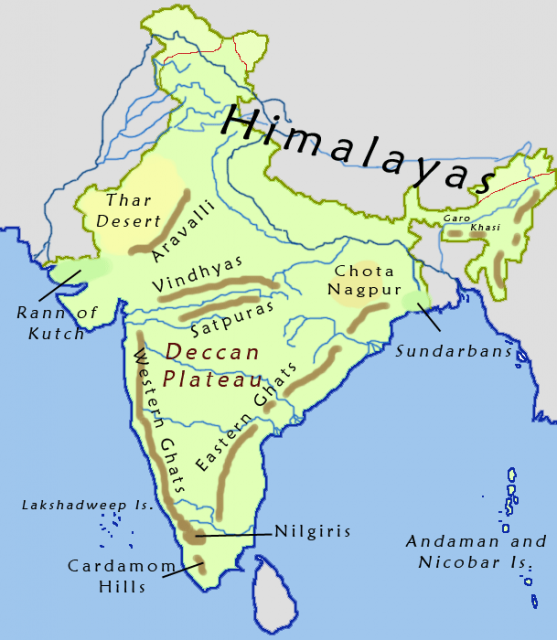Deccan Plateau
LOCATED IN INDIA, in the southern part of the peninsula south of the Indo-Gangetic Plain, the Deccan Plateau can be considered the cultural and historical heart of India, defining the subcontinent. The great epic poems of the Vedas tell of the coming of the Aryan-speaking peoples that dominate all of northern Indian today. However, the very peoples they supplanted did not disappear but were concentrated in the Deccan and maintained distinctive cultures and language groups.
Remnants of a predominantly indigenous Dravidian culture (pre-Aryan) exist in the Tamil kingdoms found by the ancient Greeks. Tamil literature from 300 B.C.E. records the social life and academic accomplishments of these peoples. Three great Tamil dynasties emerged and challenged one another in internecine fighting. The rise of Buddhism in north India did reach into the Deccan, but the south remained resistant to the kings and Moguls that came in history's wake. Islam never made significant inroads into the Deccan Plateau. The coming of the Europeans from the 15th century onward gradually affected the coastal areas and even the interior Deccan gave way under the British raj (ruler). Characteristic of their distinct culture and history, many calls for independent states have arisen since the establishment of the Indian Union in 1947.

The Deccan Plateau is believed to be an ancient remnant of the Earth's original continent, Gondwanaland, which broke up to create the continents we know today. The plateau is a great ancient shield of basalt lava that now bears the scars of its long exposure to the weathering effects of wind and water. The Vindhya Range marks the margins of the southern reaching peninsula and the Indo-Gangetic Plain. The Deccan is uplifted between 2,625 and 4,600 ft (800 and 1,400 m). The western Ghats increase in average height as they go south, reaching a maximum of 8,842 ft (2,695 km) in Kerala. The narrow coastal plain between the western Ghats and the ARABIAN SEA is marked by lagoons and backwaters. The plateau is primarily drained to the east with the headwaters of the Krishna, Bhima, and Godavari forming in the western Ghats and flowing up to 3,280 mi (1,000 km) eastward across the plateau to the BAY OF BENGAL. The eastern coastal plain is much broader and marked by the deltas of the Godavari, Mahanadi, and Kaveri rivers. The central Deccan is a series of smaller plateaus topped with rolling hills and dissected by many watercourses.
The monsoon cycle of dry and wet seasons affect the entire peninsula. The plateau has sparse but continuous dry deciduous forests across its southern third and along the eastern Ghats. To the north and in the central portions, the forest gives way to scrubland.
Over 300 million people live in the greater area of the Deccan Plateau. Sustainable resources such as forests and water are under increasing pressure. Deforested areas are being replanted with extensive monoculture that will further deplete the diversity of the ecosystem. Silting of reservoirs has been a historic problem and accelerated damming of water courses bodes ill for the long-term management of the various watersheds. Mining of the Deccan rich mineral deposits has not modernized. Techniques for the full recovery of the potential ore, management of overburden removal, and control of toxic wastes are all required.